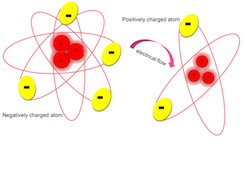In high school science class, you learned that an atom is made up of a certain number of electrons orbiting a nucleus. The atom can be positively or negatively charged, depending on a lack or excess of electrons (respectively). Otherwise, the atom is neutral. Just as the north pole of a magnet attracts the south pole of another magnet, two atoms that are oppositely charged are attracted.
 When an atom that is negatively charged collides with an atom that is positively charged, the negatively-charged atom passes excess electrons to the positively-charged atom, creating a flow of electricity when large quantities of atoms are involved.
When an atom that is negatively charged collides with an atom that is positively charged, the negatively-charged atom passes excess electrons to the positively-charged atom, creating a flow of electricity when large quantities of atoms are involved.
Voltage (V) is defined as the force which causes the flow of electricity. Current (A) refers to the electrons actually flowing in the circuit. What causes this force? Why do the electrons flow?
There are various energy sources that can trigger the flow of electrons, such as chemical batteries, wind turbines, photovoltaic cells, electric generators, and the fuel cell which is becoming more popular. Different sources offer different trigger methods to activate electron flow. Many sources such as waterfalls, oil, coal, or nuclear energy are widely used in generating commercial electricity.
While fossil fuels or nuclear energy are used to heat water into steam to drive a turbine or generator, waterfalls do the same task directly, using gravity. When the generator shaft spins, it induces magnetic fields inside the generator windings; this forces the flow of electrons.
Although electricity flows invisibly to the naked eye, one can better understand its flow by visualizing it as flowing water. Imagine you’re standing beside a river. When there is a lot of water flowing past you every second, there’s a strong current. The same goes for electricity: as more electrons flow past a point every second, the electric current is greater. The measurement for water flow is gallons per minute (or liters per second). The measurement for electrical current is amperes (A).
A 4A conductor has twice as many electrons flowing through it as a 2A conductor. A factor that affects water pressure is gravity. A creek does not have high water pressure because the water runs at a low height; a waterfall has greater water pressure because the water falls a greater distance. Similarly, a water balloon falling on you from 2 feet above will just make you wet, but a water balloon dropped from 100 feet up will knock you down with its much higher pressure. Increased water pressure functions similarly to electrical pressure or the force that pushes the flow of electrons.
The equivalent for electricity is a difference in the number of electrons between atoms in the conductor. A big difference means more electrons will move between the atoms and thus increase the current.